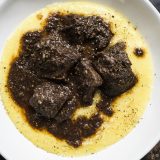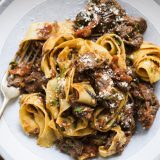Our peposo recipe makes a generous amount of stew—about 2 quarts—which gave us plenty of leftovers to use up. While we liked the reheated stew over polenta, mashed potatoes and braised beans, we also liked it in:
■ Pasta with beef ragu: In a large skillet, sauté 5 medium garlic cloves (minced) and 3 tablespoons tomato paste in 2 tablespoons extra-virgin olive oil for 1 to 3 minutes. Add a 28-ounce can whole peeled tomatoes (crushed) and simmer until thickened, 5 to 7 minutes. Add 3 cups of the Tuscan beef stew, cook for 5 to 7 minutes, then break up the beef into bite-size pieces. Add 12 ounces pappardelle or fettuccine (cooked just shy of al dente) and ½ cup pasta cooking water, toss, then cook for 3 minutes. Off heat, stir in ½ cup fresh basil. Serve with grated Parmesan.
■ Beef and broccoli rabe sandwiches: Blanch 1 pound broccoli rabe (trimmed) in a large pot of well-saltedwater for about 40 seconds; immediately transfer to an ice bath, then pat dry and cut into 1-inch pieces. Reheat 3 cups of the Tuscan beef stew, then shred the meat into bite-size pieces. In a large skillet, sauté 3 minutes. Add 5 garlic cloves (thinly sliced) and ¼ teaspoon red pepper flakes and cook for 1 minute. Off heat, toss with >span class="s1" data-redactor-span="true">2 tablespoons red wine vinegar. Place slices of provolone onto the cut sides of 4 crusty rolls (split, toasted) and broil until the cheese melts. Divide the beef and rabe among the rolls, filling the sandwiches evenly.
Traditionally a one-pot meal, peposo alla fornacina was created by the workers who made the distinctive auburn tiles for the dome of Florence’s cathedral. Toss six ingredients—cubes of marbled beef, Chianti, garlic, olive oil, salt and a handful of whole peppercorns—into a terra cotta pot, set it in the kiln at midday and feast when work is done. The long, low-heat simmer produces a rich, peppery sauce that coats the hunks of beef. It’s perfect paired with neutral starches like polenta or pasta.
We loved peposo’s richness and its hands-off cooking method. But we found that cooking all the ingredients together for hours—with a large amount of Chianti, as per tradition—resulted in beef that was tender but dry. That’s because, contrary to popular belief, cooking in liquid does not lead to moister meat.
Hot liquid conducts heat better than the dry air of a hot oven, dramatically shrinking muscle fibers in meat and squeezing out most of their moisture. But in a covered pot, without any additional liquid, the meat and aromatics cooked gently, releasing only a scant amount of juice. That meant the meat retained more moisture, giving us a more succulent stew. Removing the lid for the last hour of cooking concentrated the juices and allowed for browning and flavor development.
After the meat was fork-tender, we spooned it out of the pot, set it aside, then skimmed the fat off the meat juices. We added dry red wine to the juices, reducing them to a rich, velvety sauce on the stovetop.
Related Recipes
September-October 2018

Sign up to receive texts
Successfully signed up to receive texts!
We'll only send our very best offers - Like a $15 store credit to start.
By entering your phone number and submitting this form, you consent to receive marketing text messages (such as promotion codes and cart reminders) from Christopher Kimball's Milk Street at the number provided, including messages sent by autodialer. Consent is not a condition of any purchase. Message and data rates may apply. Message frequency varies. You can unsubscribe at any time by replying STOP or clicking the unsubscribe link (where available) in one of our messages. View our Privacy Policy and Terms of Service.





